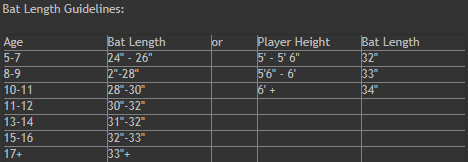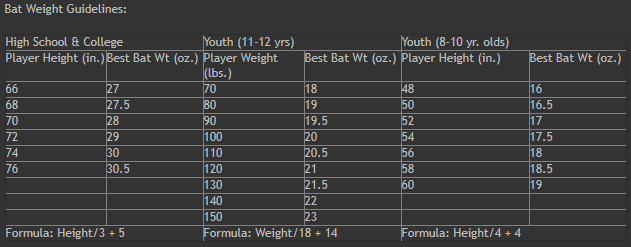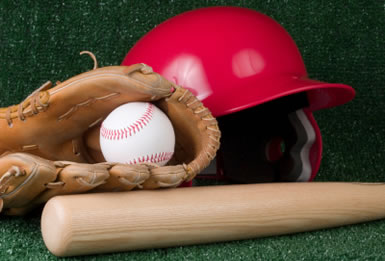Equipment & Clothing
Most Clubs or schools supply players with Baseball equipment. If you want to invest in your own gear, you can go to a specialist retailer like Sirius Sports for expert advice.
The basic equipment and clothing required to play Baseball includes:
Bat
When choosing a baseball bat, there are a number of factors that must be taken into consideration, including level of play, size of the batter, cost and comfort.
Aluminium / composite baseball bats are generally preferred to wooden bats due to their light weight and high strength (note: pro players are allowed to use wood bats only). Lighter bats are generally preferable to heavier bats as they allow the hitter to generate enough speed to put some "oomph" into it (although there are restrictions about bat weights at most levels). Additionally, aluminium bats can provide more "pop" of the baseball off the bat, and are much more durable (therefore cost effective) than wooden bats. Bats today are becoming increasingly high tech and expensive - with youth bats reaching $200+ price levels.
The comfort of the baseball bat to the hitter is the most important factor in choosing a bat. As with any piece of sports equipment, be it your baseball glove or rugby shorts - the more comfortable you are the better. Take a few swings with the bat and try to picture yourself in a game. Better yet, borrow a bat from one of your teammates and see how it feels - a swing in the store doesn't always feel like a swing at the plate! When choosing a bat for younger players, make sure they can swing the bat without struggling - we've all seen the young players struggling to swing bats that are far too big for them.
Size of the Bat (Length and Weight)
Another important factor in choosing the right sized baseball bat is the height of the batter. In general, tall batters should use longer bats. Below are two tables with general guidelines for choosing baseball bat length.

Worth Sports conducted a study with the University of Arizona, in which they determined the best bat weights for hitters, based on their height. The table below summarizes their findings.

Level of Play & Regulations
The level of play should always be a consideration in choosing a baseball bat, as every level from little league through major league has different regulations regarding what bat sizes and materials are allowed.
Baseball bats are measured using their length to weight ratio, a negative number that represents how many ounces a bat weighs compared to its length in inches. For example, a 32 inch bat that weighs 28 ounces is a - 4. The largest ratio is in the range of -12 (for little league bats), while college and high school bats are restricted to a - 3. These restrictions are for safety reasons - a college or high school player swinging a very light bat (-4 +) would simply have too much power and could pose a danger to other players on the field. Make sure to check the regulations of your league before buying a baseball bat!
Helmet
Helmets must be worn by the batter and all base runners to protect themselves from any hit or thrown balls. It is recommended that, at junior level, all infielders wear a helmet with a face-guard.
Glove
A glove is used by every fielder. They are made of leather and have a pocket between the thumb and first finger that allows for the ball to be caught. There is a tremendous range of gloves available - what is right for you depends on the level competition, whether you are left-handed, right-handed, or ambidextrous, and the position you play.
The catcher and 1st base player can use a mitt, which is an extended version (length and width) of a glove
Infielders tend to use a smaller glove (9"-11"/23-28cm)) for quick release to make the throw
Outfielders use long gloves (13"-14"/33-35cm) to extend their reach.
Baseball: of various sizes and density have been developed for players of different ages and abilities. For example: It is recommended that children under 12 years use a soft-core Incrediball or similar low impact baseball as it is easier to grip the ball correctly for throwing, and the risk of soft tissue injury is reduced if the player is hit by the ball.
Catcher's gear
Catcher's gear is protective shielding only worn by the catcher. It includes a facemask, chest protector, shin guards and a catcher's glove. It is designed to protect the catcher from being hit by a bat, or a pitched or batted ball.
Clothing
Appropriate clothing is important to ensure you are comfortable, can move easily and to minimise the risk of injury.
Players, especially at the elite level, slide and dive regularly so need to wear protective, padded sliding pants under playing pants.
For competition, most Clubs wear a distinctive Baseball uniform that comprises a cap, shirt, undershirt, sliders, socks, belt, and pants (Not shorts). At the back of the uniform a number must be visible.


BASEBALL NEW ZEALAND
P.O. Box 301 257
Albany
Auckland
New Zealand
Regional Associations
Wellington Baseball
International Member Organisations
MLB
 Admin Login
Admin Login